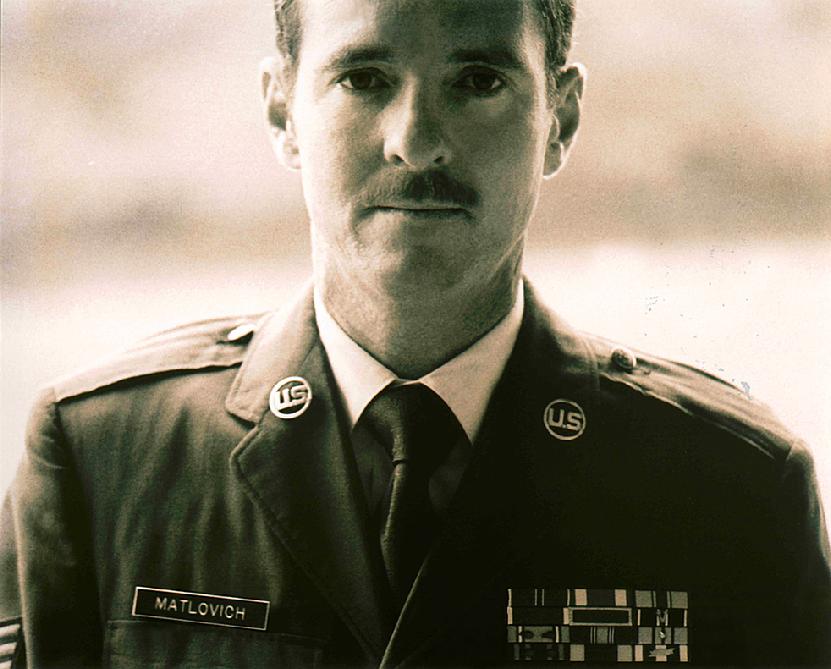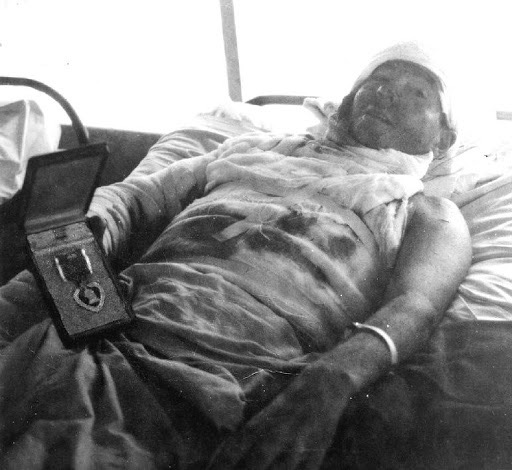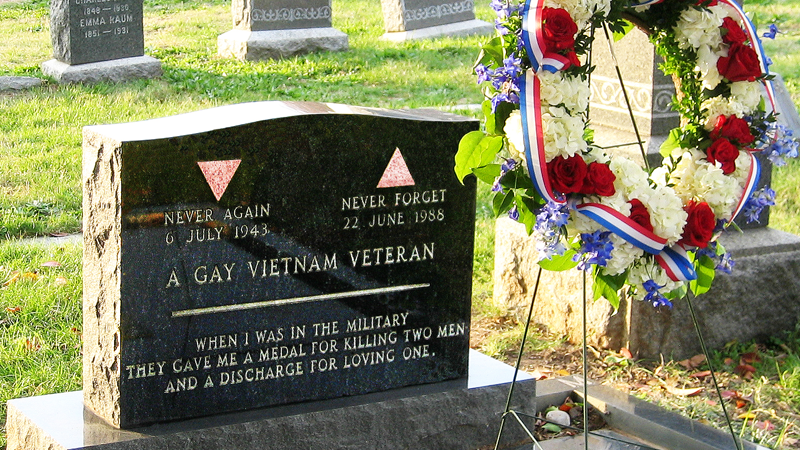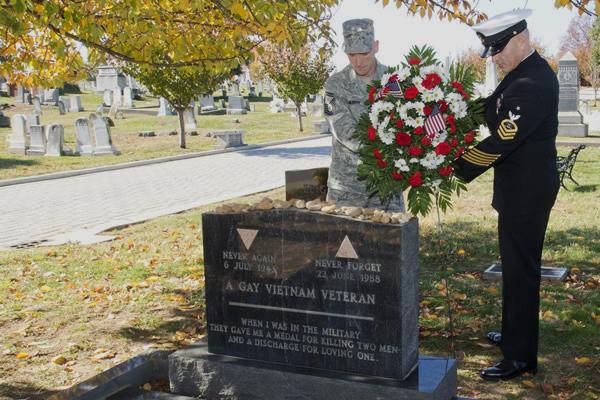Technical Sergeant Leonard Philip Matlovich was a Vietnam War veteran, race relations instructor, and recipient of the Purple Heart and the Bronze Star. He was a fierce advocate of LGBT rights and fought to end discrimination of sexuality. Matlovich was also a Latter-day Saint and found himself at odds with his religion and sexuality.

Matlovich was the first gay service member to purposely out himself to the military to fight their ban on gays, and perhaps the best-known openly gay man in America in the 1970s next to Harvey Milk. His fight to stay in the United States Air Force after coming out of the closet became a cause célèbre around which the gay community rallied. His case resulted in articles in newspapers and magazines throughout the country, numerous television interviews, and a television movie on NBC.

His photograph appeared on the cover of the September 8, 1975, issue of Time magazine, making him the first openly gay person to be featured on the cover, and a symbol for thousands of gay and lesbian service-members and gay people generally.
Born at Hunter Air Force Base in Savannah, Georgia, Matlovich was the only son of a career Air Force sergeant. He spent his childhood living on military bases, primarily throughout the Southern United States. Not long after he enlisted at 19, the United States increased military action in Vietnam, about ten years after the French had abandoned active colonial rule there. Matlovich volunteered for service in Vietnam and served three tours of duty. He was seriously wounded when he stepped on a landmine in Đà Nẵng.

During his service in Vietnam, Matlovich also became much more aware of, if not exactly comfortable with, his homosexuality. Through his working relationships and friendships with African Americans, he also found himself unlearning many of the racial prejudices he had inherited from his upbringing in the South. Yet he remained conflicted.
Shortly after his service in Vietnam, Leonard Matlovich converted to Mormonism in an attempt to reconcile his conservative values with his need for a new direction in his life. Matlovich often found himself at odds with the Church of Jesus Christ of Latter-day Saints and their opposition to homosexual behavior; he was twice excommunicated by the Church for homosexual acts. His desire to feel loved and accepted by a faith community kept him close to the LDS church, though realizing the painful irony: that his faith community did not want him close to them.
Perhaps the most painful aspect of the whole experience for Matlovich was his revelation to his parents. He told his mother by telephone. She was so stunned she refused to tell Matlovich’s father. Her first reaction was that God was punishing her for something she had done, even if her Roman Catholic faith would not have sanctioned that notion. Then, she imagined that her son had not prayed enough or had not seen enough psychiatrists. His father finally found out by reading it in the newspaper, after his challenge became public knowledge on Memorial Day 1975 through an article on the front page of The New York Times and that evening’s CBS Evening News with Walter Cronkite. Matlovich recalled, “He cried for about two hours.” After that, he told his wife that, “If he can take it, I can take it.”
While stationed in Florida near Fort Walton Beach, he began frequenting gay bars in nearby Pensacola. “I met a bank president, a gas station attendant – they were all homosexual”, Matlovich commented in a later interview. In 1973, when he was 30, he “came out” to his friends, but continued to conceal the fact from his commanding officer. Having realized that the racism he had grown up around was wrong, he volunteered to teach Air Force Race Relations classes, which had been created after several racial incidents in the military in the late 1960s and early 1970s. He became so successful that the Air Force sent him around the country to coach other instructors. Matlovich gradually came to believe that the discrimination faced by gays was similar to that faced by African Americans.
In March 1974, previously unaware of the organized gay movement, he read an interview in the Air Force Times with gay activist Frank Kameny, who had counseled several gay people in the military over the years. He contacted Kameny, who told him he had long been looking for a gay service member with a perfect record to create a test case to challenge the military’s ban on gays. Four months later, he met with Kameny at the longtime activist’s Washington, D.C. home. After several months of discussion with Kameny and ACLU attorney David Addlestone during which they formulated a plan, he hand-delivered a letter to his Langley AFB commanding officer on March 6, 1975. When his commander asked, “What does this mean?” Matlovich replied, “It means Brown versus the Board of Education” – a reference to the 1954 landmark Supreme Court case outlawing racial segregation in public schools.
From the moment his legal case was revealed to the public, Matlovich was repeatedly called upon by gay groups to help them with fundraising and advocating against anti-gay discrimination, helping lead campaigns against Anita Bryant’s efforts in Miami, Florida, to overturn a gay nondiscrimination ordinance and John Briggs’ attempt to ban gay teachers in California.
In 1986, Matlovich felt fatigued, then contracted a prolonged chest cold he seemed unable to shake. When he finally saw a physician in September of that year, he was diagnosed with HIV/AIDS. Too weak to continue his work he was among the first to receive AZT treatments, but his prognosis was not encouraging. He went on disability benefits and became a champion for HIV/AIDS research for the disease which was claiming tens of thousands of lives in the Bay Area and nationally. He announced on Good Morning America in 1987 that he had contracted HIV.
Despite his deteriorating health, he tearfully made his last public speech on May 7, 1988, in front of the California State Capitol during the March on Sacramento for Gay and Lesbian Rights:
… And I want you to look at the flag, our rainbow flag, and I want you to look at it with pride in your heart, because we too have a dream. And what is our dream? Ours is more than an American dream. It’s a universal dream. Because in South Africa, we’re black and white, and in Northern Ireland, we’re Protestant and Catholic, and in Israel we’re Jew and Muslim. And our mission is to reach out and teach people to love, and not to hate. And you know the reality of the situation is that before we as an individual meet, the only thing we have in common is our sexuality. And in the AIDS crisis – and I have AIDS – and in the AIDS crisis, if there is any one word that describes our community’s reaction to AIDS, that word is love, love, love.
On June 22, 1988, less than a month before his 45th birthday, Matlovich died in Los Angeles of complications from HIV/AIDS. His tombstone, meant to be a memorial to all gay veterans, does not bear his name. It reads, “When I was in the military, they gave me a medal for killing two men and a discharge for loving one.” Recognizing military officials would not then allow such a marker in Arlington Cemetery, Matlovich chose a gravesite in Congressional Cemetery in Washington, D.C. Another reason was because the man many believe to have been the greatest love of poet Walt Whitman, Peter Doyle, is buried there. He chose the same row where the graves of FBI Director J. Edgar Hoover and Hoover’s longtime Assistant Director and heir Clyde Tolson are as a kind of “last laugh”.

Before his death, Matlovich donated his personal papers and memorabilia to the GLBT Historical Society, a museum, archives and research center in San Francisco. Matlovich’s gravesite has been a site of attraction and ceremony for LGBT rights activists since his interment including an annual LGBT Veterans Day observance, and several individuals and couples have chosen to also be buried in Congressional Cemetery identifying their being gay on their tombstones per his suggestion.



